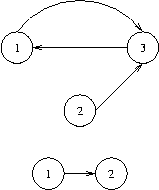POJ 2553 The Bottom of a Graph
来源:互联网 发布:淘宝怎么开店好赚钱呢 编辑:程序博客网 时间:2024/05/15 23:48
http://poj.org/problem?id=2553
The Bottom of a Graph
Time Limit: 3000MSMemory Limit: 65536KTotal Submissions: 9130Accepted: 3789
Description
We will use the following (standard) definitions from graph theory. Let V be a nonempty and finite set, its elements being called vertices (or nodes). Let E be a subset of the Cartesian product V×V, its elements being called edges. Then G=(V,E) is called a directed graph.
Let n be a positive integer, and let p=(e1,...,en) be a sequence of length n of edges ei∈E such that ei=(vi,vi+1) for a sequence of vertices (v1,...,vn+1). Then p is called a path from vertex v1 to vertex vn+1 in G and we say that vn+1 is reachable from v1, writing (v1→vn+1).
Here are some new definitions. A node v in a graph G=(V,E) is called a sink, if for every node w in G that is reachable from v, v is also reachable from w. The bottom of a graph is the subset of all nodes that are sinks, i.e.,bottom(G)={v∈V|?w∈V:(v→w)?(w→v)}. You have to calculate the bottom of certain graphs.
Let n be a positive integer, and let p=(e1,...,en) be a sequence of length n of edges ei∈E such that ei=(vi,vi+1) for a sequence of vertices (v1,...,vn+1). Then p is called a path from vertex v1 to vertex vn+1 in G and we say that vn+1 is reachable from v1, writing (v1→vn+1).
Here are some new definitions. A node v in a graph G=(V,E) is called a sink, if for every node w in G that is reachable from v, v is also reachable from w. The bottom of a graph is the subset of all nodes that are sinks, i.e.,bottom(G)={v∈V|?w∈V:(v→w)?(w→v)}. You have to calculate the bottom of certain graphs.
Input
The input contains several test cases, each of which corresponds to a directed graph G. Each test case starts with an integer number v, denoting the number of vertices of G=(V,E), where the vertices will be identified by the integer numbers in the set V={1,...,v}. You may assume that 1<=v<=5000. That is followed by a non-negative integer e and, thereafter, e pairs of vertex identifiers v1,w1,...,ve,we with the meaning that (vi,wi)∈E. There are no edges other than specified by these pairs. The last test case is followed by a zero.
Output
For each test case output the bottom of the specified graph on a single line. To this end, print the numbers of all nodes that are sinks in sorted order separated by a single space character. If the bottom is empty, print an empty line.

Sample Input
3 31 3 2 3 3 12 11 20
Sample Output
1 32
Source
Ulm Local 2003
tarjan +缩点 统计scc图中出度为0的顶点,并把这些顶点所包含的点的值 按升序输出;
#include<iostream>
#include<cstring>
#include<algorithm>
#include<cstdlib>
#include<vector>
#include<cmath>
#include<stdlib.h>
#include<iomanip>
#include<list>
#include<deque>
#include<map>
#include <stdio.h>
#include <queue>
#include <stack>
#define maxn 5500
#define ull unsigned long long
#define ll long long
#define reP(i,n) for(i=1;i<=n;i++)
#define rep(i,n) for(i=0;i<n;i++)
#define cle(a) memset(a,0,sizeof(a))
#define mod 90001
#define PI 3.141592657
#define INF 1<<30
const ull inf = 1LL << 61;
const double eps=1e-5;
using namespace std;
bool cmp(int a,int b)
{
return a>b;
}
vector<int>G[maxn];
stack<int>s;
int n;
int pre[maxn],lowlink[maxn],sccno[maxn],dfs_clock,scc_cnt;
int a[maxn];
void dfs(int u)
{
pre[u]=lowlink[u]=++dfs_clock;
s.push(u);
for(int i=0;i<G[u].size();i++)
{
int v=G[u][i];
if(!pre[v])
{
dfs(v);
lowlink[u]=min(lowlink[u],lowlink[v]);
}
else if(!sccno[v])lowlink[u]=min(lowlink[u],pre[v]);
}
if(lowlink[u]==pre[u])
{
scc_cnt++;
for(;;)
{
int x=s.top();s.pop();
sccno[x]=scc_cnt;
if(x==u)break;
}
}
}
void find_scc(int n)
{
dfs_clock=scc_cnt=0;
cle(pre),cle(sccno);
for(int i=1;i<=n;i++)
if(!pre[i])dfs(i);
}
void solve()
{
find_scc(n);
int outdegree[maxn];
cle(outdegree);
for(int i=1;i<=n;i++)
for(int j=0;j<G[i].size();j++)
{
int k=G[i][j];
if(sccno[i]!=sccno[k])
{
outdegree[sccno[i]]++;
}
}
cle(a);
int p=0;
for(int i=1;i<=scc_cnt;i++)
if(outdegree[i]==0)
{
for(int j=1;j<=n;j++)
if(sccno[j]==i)
a[p++]=j;
}
sort(a,a+p);
for(int i=0;i<p;i++)
{
printf("%d",a[i]);
if(i==p-1)printf("\n");
else printf(" ");
}
}
int main()
{
#ifndef ONLINE_JUDGE
freopen("in.txt","r",stdin);
#endif
//freopen("out.txt","w",stdout);
int m,a,b;
while(scanf("%d",&n))
{
if(n==0)break;
for(int i=0;i<maxn;i++)
G[i].clear();
scanf("%d",&m);
for(int i=1;i<=m;i++)
{
scanf("%d%d",&a,&b);
G[a].push_back(b);
}
solve();
}
return 0;
}
0 0
- POJ 2553 The Bottom of A Graph
- poj 2553 The Bottom of a Graph
- poj 2553 The Bottom of a Graph
- poj 2553 The Bottom of a Graph
- poj 2553 The Bottom of a Graph
- POJ 2553-The Bottom of a Graph
- poj 2553 The Bottom of a Graph
- POJ-2553 The Bottom of a Graph
- POJ 2553 The Bottom of a Graph
- POJ 2553The Bottom of a Graph
- POJ 2553 The Bottom of a Graph .
- poj 2553 The Bottom of a Graph
- POJ 2553 The Bottom of a Graph
- POJ 2553 The Bottom of a Graph
- poj 2553 The Bottom of a Graph
- POJ 2553 The Bottom of a Graph
- The Bottom of a Graph POJ
- poj 2553 The Bottom of a Graph(Tarjan~)
- HDU 1556 Color the ball
- 1B. Spreadsheets
- HDU 5174 Ferries Wheel
- Tarjan算法
- POJ 1236 Network of Schools
- POJ 2553 The Bottom of a Graph
- POJ 2186 Popular Cows
- HDU 5050 Divided Land
- HDU 4027 Can you answer these queries?
- Kosaraju算法
- HDU 2063 过山车
- HDU 3861 The King’s Problem
- CF 293 A. Vitaly and Strings
- centos7 下双网卡如何配置静态IP
原创粉丝点击
热门IT博客
热门问题
老师的惩罚
人脸识别
我在镇武司摸鱼那些年
重生之率土为王
我在大康的咸鱼生活
盘龙之生命进化
天生仙种
凡人之先天五行
春回大明朝
姑娘不必设防,我是瞎子
比邻提示音下载
比领而交
比领克02性价比更高的
比高
毕
毕哩毕哩
毕哩哩毕哩
毕导
毕马威
诸天纪庄毕凡
今日事今日毕
计春毕
毕打自己人
毕马威会计师事务所
毕书尽
群贤毕至
毕路蓝缕
毕书文
宜毕高速公路
毕书尽承认恋情
纳贡毕力格
毕方鸟
毕德国
毕男原型
毕力吉翁
今日事今日毕下一句
能事毕矣
鄂毕河
毕力格
毕业鉴定
毕业好多年
毕业
毕业的我们
毕业季
毕业设计
毕业歌
毕业英语
毕业季歌曲
毕业时间
大学毕业
毕业主题


